How Healthy is Your Home?

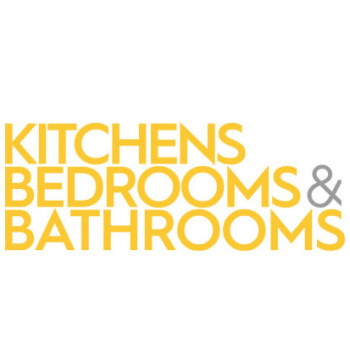
How Healthy is Your Home?
We spend 90% of our time indoors, but have you thought about your environment? Pollution, lack of light, carcinogens and energy-draining appliances are only a few areas to consider. We look at how to transform your spaces into sanctuaries of wellbeing and sustainability.
By CHARLOTTE LUXFORD for KITCHENS BEDROOMS & BATHROOMS MAGAZINE
In the last decade, our priorities have shifted massively, with the wellness industry valued in 2018 at £2.8 trillion by the Global Wellness Institute. We are prioritising lifestyle, taking health into our own hands, and spending more on wellbeing than ever. Plus it's widely reported that modern-day jobs have left many of us overworked with endemic stress, mental health issues, and trouble sleeping. On top of that, we've had to deal with a pandemic, which brings its own anxieties and health concerns and also has dramatically changed our relationship with our homes and intensified our sense of domesticity.
More time at home has pushed us to adapt our living spaces, whether it's decluttering, therapeutic cooking, carving out spaces for exercise, meditating, working from home, or transforming the bathroom into a personal sanctuary. We're also paying more attention to the world around us. Sustainability is no longer a niche idea but a mainstream term, thanks to the campaigning of Greta Thunberg and David Attenborough, who have been highlighting issues of climate change and plastic pollution, making us more mindful of our consumer habits and the collective responsibility to change.
Caring for ourselves and each other have never been as important, too, so we've looked at how our kitchens, bedrooms and bathrooms can work with us to create the most healthy environment, both physically and emotionally. We've looked at how to tailor these key spaces to your needs and improve daily life with the latest technology - from water-saving products to air purifiers - and how to boost your home's energy efficiency and, ultimately, make it a healthy and happy place to live.
LIVE WELL
In the kitchen
Flooding your home with natural light is an important way to regulate your body's circadian rhythm, get a dose of much-needed vitamin D, and boost mental wellbeing. "Combining roof windows with vertical ones or patio doors ensures daylight will travel as far as possible into a room," says Grant Sneddon, product manager at Velux. "I'd recommend that vertical and roof glazing covers up to 15-20% of a space's floor area to allow for maximum light and ventilation."
Bringing the outdoors in - otherwise known as biophilic design - can also have real health benefits. "Incorporating nature into your built environment has been demonstrated through research to reduce stress, blood pressure and heart rates, while increasing productivity, creativity, and self-reported rates of wellbeing," says biophilic designer Oliver Heath. So how do you bring this into your home? Where possible, create a direct link to your garden via patio doors - but if that's not an option, consider adding your very own herb garden into your kitchen or you could install a living wall to add greenery to your dining area.
Ergonomics is often a buzzword associated with office design, but it's important in a kitchen too, especially with more of us living in multi-generational households. "A good ergonomic kitchen minimises movement, so you spend less energy bending, stretching, lifting, and cleaning," says Adam Thomas, who led the design on Symphony's Freedom range of accessible kitchens. Instead of installing hard-to-reach cabinets, think about using drawers and extensive pull-out systems to bring items towards you. Uninterrupted, height-adjustable worktops with accessible areas provide greater functionality, while a surface with a raised waterfall edge helps prevent spillages onto the floor. "Position your appliances close together to avoid carrying heavy pots and pans across the room, and opt for a mid-height oven and innovative products such as AEG's ComfortLift dishwasher with a slide-and-lift basket to avoid unnecessary bending," says Adam. "It's also sensible to future proof your design, such as by planning electrics to allow for the installation of a rise-and-fall worktop without rewiring."
LIVE WELL
In the bathroom
"The slower pace of life many of us have become accustomed to over the past year has seen us setting aside more 'me-time' and developing extensive self-care routines we were previously too busy for," says Lauren Foulds, product manager at Heritage Bathrooms. "There's been a huge demand for spa-inspired experiences at home, with an increased focus on creating a space that promotes wellness."
The bathroom design industry has responded to this call for highly personalised spaces with products that cater to the specific needs of each individual. Designs such as Hansgrohe's new Raintunes or Dornbracht's Sensory Sky showers combine rain functions, chromotherapy lighting, sound, and scents to create the ultimate spa-style experience. Speaking of technology in the bathroom, the shower toilet has become increasingly popular, with the likes of Grohe's Sensia Arena, Toto's Neorest Washlet and Duravit's SensoWash offering a hands-free cleaning experience complete with heated seats, massage and washlet systems, self-lowering seats, and integrated nightlights. Bathroom mirrors are being designed with integrated Bluetooth to play music, while some - such as the Qaio - are even able monitor personal health via your heart rate, weight and dental hygiene.
If you're a bit of a technophobe or simply looking for a quick update, focus on simple pleasures - for example turning your soak in the tub into more of a ritual. 'Bathscaping' which means styling the area around your bath to create a haven of relaxation, has become something of a lockdown trend. Invest in a bath board and surround yourself with plants, aromatherapy candles, a good book and maybe even a glass of your favourite tipple. Dimmable lighting is a must when planning your bathroom, as is ample storage to help you create a serene and clutter-free space.
"Alongside an uplift in wellness, there's also the concept of multi-generational design when thinking about 'living well' in bathroom design," says Yousef Mansuri, head of design at CP Hart. "Future proofing your bathroom is a wise investment that will ensure the needs and wellbeing of everyone in the household are met long-term." Companies including Villeroy & Bosch and Grohe have launched stylish accessible bathroom products, such as washbasins with subtle handles for stability, thermostats that protect against scalding, high-level taps for comfort with swivel spouts or those that can be operated with one hand, as well as infinity anti-slip shower trays that can be installed flush to the floor, creating a wetroom-style scheme.
LIVE WELL
In the bedroom
Getting a good nights sleep is key to living well. Yet since the pandemic hit, anxiety, stress and depression as the results of our current circumstances have made it even harder. According to a recent survey commissioned by Sleepstation, The Sleep Council, and The Sleep Charity, almost half of respondents are finding it harder to fall asleep since Covid-19 took hold, while more than 75% say lack of sleep is interfering with their ability to function during the day. Is that you?
It's vital to create a sanctuary that's free from work and the chaos of the day, both physically and mentally. "The main focus of the bedroom should be on sleep, so remove other items like electronics, books, piles of laundry, and anything work-related," says Monty George, co-founder at Furniturebox. "Flow is key, so create a clear line between the bed and the door, and keep things easily accessible to minimise frustration."
As hard as it sounds, keep your phone outside of the bedroom - the blue-spectrum light can play havoc with your body's circadian rhythm, triggering your brain to be awake and alert, according to Scooms founder Emily Attwood. Waking up in the right frame of mind is equally important, so consider a light therapy lamp from companies such as Lumie or Philips. These imitate natural sunrise to help combat seasonal affective disorder (SAD) and encourage a better, more consistent sleep.
Noise is also a serious problem, whether it's blaring music, barking dogs, or late-night Zoom calls, leading to stress and sleep deprivation. While some materials such as carpets absorb sound, hard surfaces including tiles, plain walls and wooden floors reflect it. For a longer-term acoustic solution, look at installing soundproofing panels such as the Oscar Iso-Mount ceiling-mounted design or Noisestop's wall panels and make sure to put noise-reducing underlay under flooring.
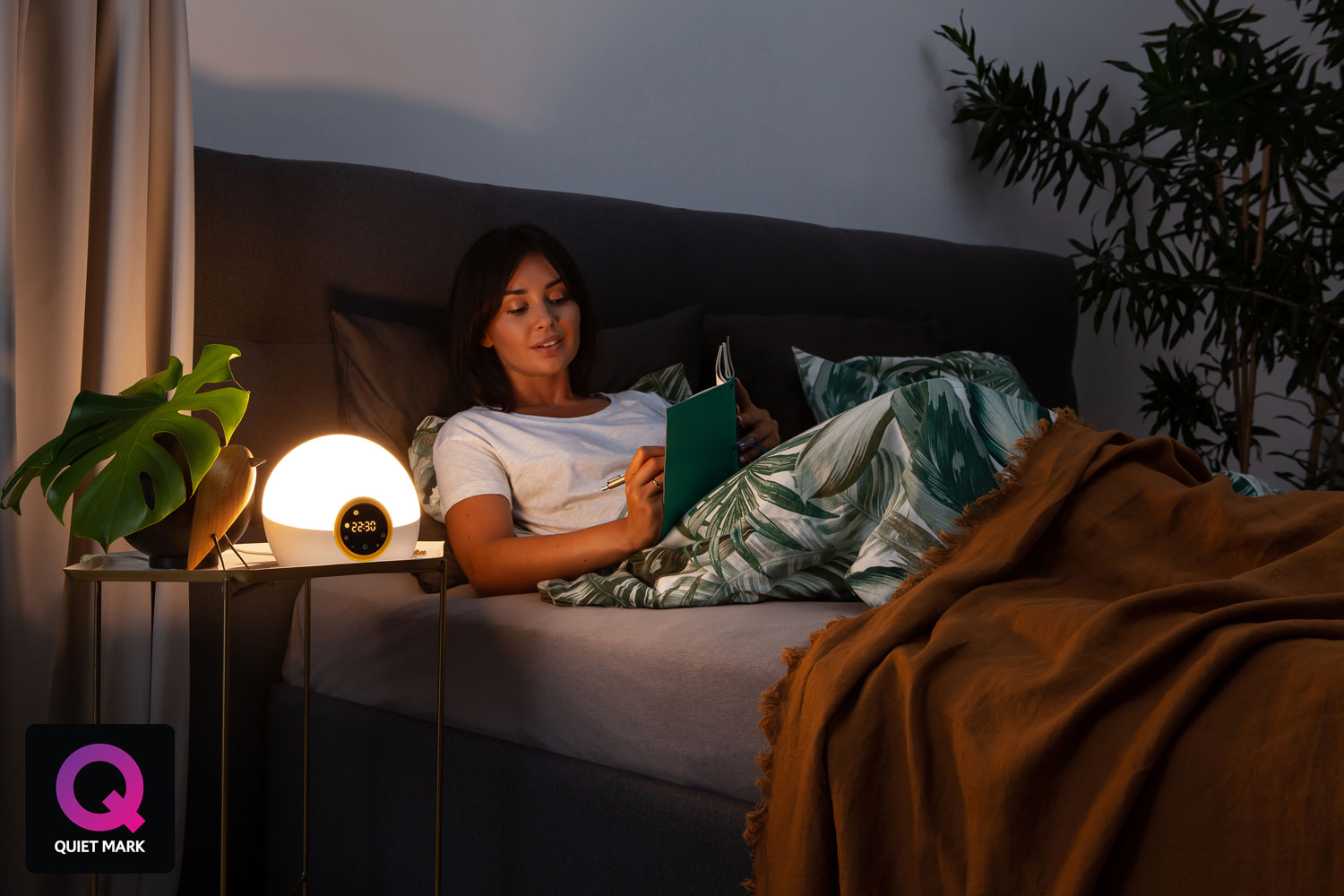
Image: The Lumie Bodyclock Rise 100, £79. mimics sunrise, while a fading sunset creates a relaxing mood at bedtime. Waking like this helps regulate your sleep-wake cycle and has been shown to boost mood, energy and productivity levels.
ENERGY EFFICIENT
Kitchen
In the UK, 22% of carbon emissions come from our homes, with the kitchen being one of the most energy-hungry rooms in the house, according to the Energy Saving Trust. "When looking to design a more efficient kitchen, choose appliances with a good energy rating," says Max McCormick, category manager at Miele GB. "The better the rating, the less energy it uses, making it more environmentally friendly as well as being extra efficient in its everyday operation and cheaper to run. Energy-efficient appliances also offer the greatest opportunity to reduce C02 emissions, even when compared to the manufacturing process."
Energy ratings were previously deemed misleading, with as many as 60% of new appliances automatically elevated to the top of the scale, which ranged between A to A+++. A new energy label was launched in March this year, from A-G in the interest of fairness and transparency, with a QR code that allows you to instantly get more information by scanning it with your phone.
Look for energy-saving features when choosing appliances, such as Hotpoint's ActiveDry system, which automatically opens the dishwasher 10cm at the end of the cycle, letting humidity out and fresh air in, to produce 60% better drying results while reducing consumption by 20%. Washing machines with effective 'eco' programmes such as LG's Turbowash360 that can finish a cycle in 39 minutes and remove 99.9% of allergens with Steam+ technology - or Whirlpool's 6th Sense technology which automatically adapts the cycle by assessing how dirty your laundry is, saving up to 70% of energy, water and time, as well as reducing detergent use. Heat pump technology has also revolutionised tumble dryers, using up to 50% less energy than vented or condenser models. Also key for efficiency are induction hobs - they only heat the pan's surface, compared to conventional gas cooking, where a lot of energy is lost around the edge of the pot.
It's also worth paying attention to decibel ratings on the appliance specification and choosing products with Quiet Mark certification. "With lengthy programmes, the last thing you need is to be disturbed by three hours of washing, which ends with a spin cycle over 80dB - the same noise as busy city traffic," Quiet Mark's experts say.
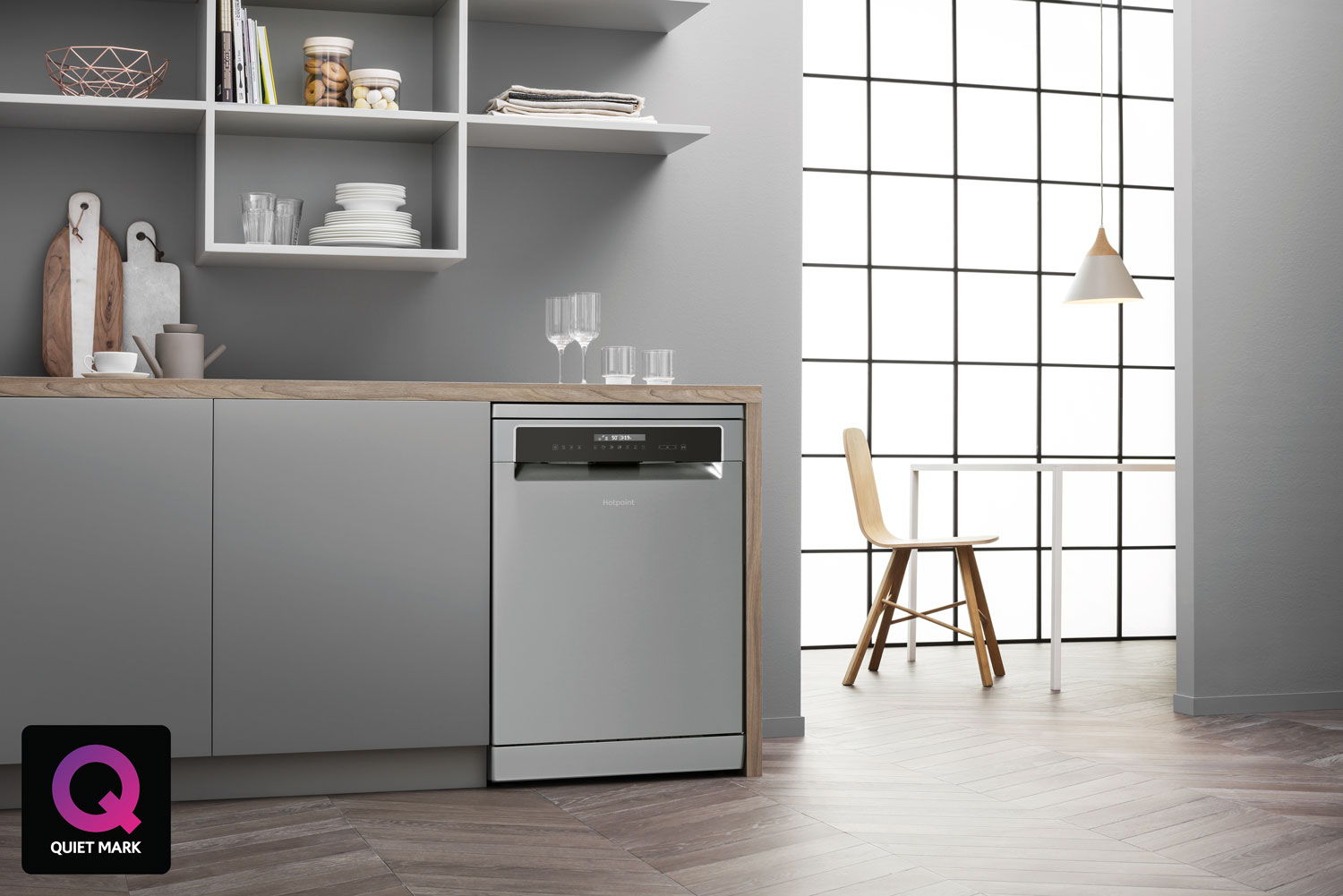
Image: Hotpoint's freestanding HFP 5041 WLG X UK dishwasher with ActiveDry, £499. naturally air dries dishes by automatically opening the door at the end of the cycle, producing drying results while helping you save money and energy.
ENERGY EFFICIENT
Bathroom
UK homes use around 140 litres of water per day, with the WC being the second-biggest user, only behind showering. According to NI Direct, we flush away as much water in a day as we drink in a whole month. Look to install a displacement device in the cistern, which reduces the amount of water used for each flush by up to two litres. Also consider low-flush or dual-flush products - these use around six litres per use, compared to nine or more for more traditional designs. "One of the quickest and easiest ways to save energy and water within the bathroom is by installing aerators on all taps, which can result in savings of up to 60% a year," says Derek Aaronson, founder at Hart Home. "They steady the flow, which not only saves water but also provides a more pleasurable experience, especially in the shower. They can even help to minimise pollutants in the atmosphere, helping with infection control." Hansgrohe offers an EcoSmart aerator across a range of its showers, while Methven uses Aurajet technology to deliver a water-saving yet luxurious experience. A good test to check whether an eco model is suitable is to put a two-litre container on the shower floor - if it takes less than 12 seconds to fill when the shower's running on full whack, a water-saving or low-flow showerhead could work for you.
There are a few other simple ways to save energy in the bathroom. If everyone in a four-person household spent one minute less in the shower each day, you could save £75 a year. Lowering the thermostat on your water heater can also help - for every 10°C you reduce the temperature, you can save 3 - 5% on your bill.
ENERGY EFFICIENT
Bedroom
Draught proofing is one of the most effective ways to save energy and money. In the bedroom, block gaps in the window with dedicated strips. If you have an unused chimney, you can either fit a 'cap', normally made from terracotta, or buy a draught excluder. Gaps between floorboards can amount to the equivalent of a small window and account for as much as 10% of the total heat loss in the average UK home, so it's worth insulating between the joists as well as using floorboard filler products such as DraughtEx. A good-quality underlay and carpet can prevent 15 times as much heat escaping as the same thickness of standard fibreglass floor insulation, too.
Blackout curtains and blinds not only help you sleep better, but they're also great for maintaining a consistent temperature in the bedroom - essential for a perfect night's sleep. Use them to block out hot sunlight in summer and keep them open during the day in winter to allow natural heat from the sun in, closing them at night for extra insulation.
A quick fix is to replace any incandescent light bulbs in your bedroom with LEDs - these use up to 80% less energy, are better for the planet, and last up to 25 times longer. It goes without saying, but switch them off when you leave the room. Similarly, don't forget to keep your door shut, plus any other doors in the room, such as wardrobes or one leading to an en suite, to avoid increasing the volume of space that needs to be cooled or heated. Even simpler, turning down your thermostat by 1°C can typically save you around £80 per year, according to the Energy Saving Trust, while thermostatic radiator valves could save you £75 a year and reduce your carbon emissions.
BREATHE EASY
Indoor air pollution is up to five times more toxic outdoors, according to sustainable interiors expert Charlie Lemmer. "We spend around 90% of our time inside, so it's imperative that our air quality is the best it can be to support our respiratory system as much as possible in these times of Covid-19," she says. What's more, increased indoor air pollution can lead to a number of health concerns, including increased risk of pneumonia, exacerbated asthma and allergy symptoms, chronic obstructive pulmonary disease, and even lung cancer, according to the British Lung Foundation. So how do you improve the air so you can breathe easy at home?
BREATHE EASY
In the kitchen
One of the first changes to make is to strip your home of potential pollutants. MDF, which is used in a lot of kitchen products, isn't only bad for the environment, it's also a source of formaldehyde, as well as other volatile organic compounds (VOCs), which are chemicals that become gases at room temperature. The most common health effects include irritation to the mucous membranes, sensitive eyes, headaches, dizziness, and nausea. VOCs can also be found in paint, so make sure you choose one that's free of those agents if you're opting for a painted kitchen or if you're decorating.
Also look at how you cook. Gas stoves emit small amounts of nitrogen dioxide, carbon monoxide, and formaldehyde, while induction hobs which are powered by electricity so don't have an open flame are often considered more eco-friendly. A good extractor hood is key in any kitchen to help clear the air from grease and condensation quickly when you're busy in the kitchen. Choose from a ducted (with vents to the outside) or recirculating model, which has carbon filters to purify the air before feeding it back into your space. It's essential to clean and change the filter regularly to remove any polluting residue. To figure out the minimum extraction rate you require, it's a simple sum of your room's height x length x width x 10.
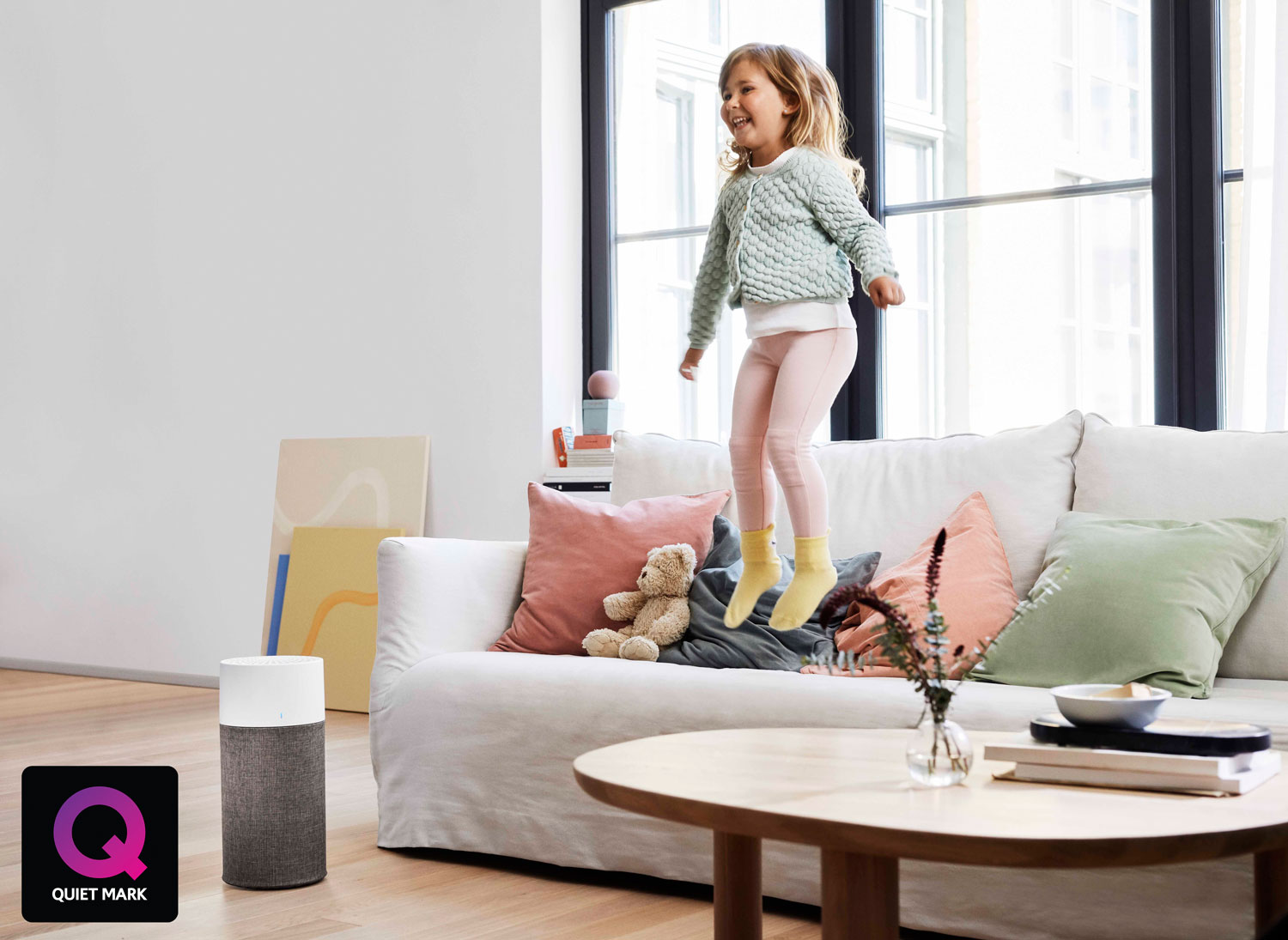
Image (above and article header): Built-in sensor monitors in BlueAir's new Blue 3210 air purifier. £159. keep track of indoor air quality and automatically increases its speed. It's HEPASilent technology removes at least 99.97% of airborne particles, including pet dander, PM2.5 and VOCs.
If you've got an open-plan kitchen, why not consider an air purifier with a high-efficiency particulate air (HEPA) filter from companies such as Meaco, Hoover, and BlueAir? "A true HEPA filter traps most bacteria, pathogens, microbial spores, pollens, and some virus particles," says Chris Michael, director at Meaco. "Air filters are an important part in managing airborne allergens and, for serious sufferers, can make life a lot more bearable." However, a common mistake is to buy one that's too small for the room - or they fail to match the allergy to the filter, according to Michael. "The only way to reliably remove pollutants is by circulating the entire volume of air in a room several times an hour," he says. "To select the correct appliance, you need to know what you're allergic to and the cubic air volume of the room you want to clean."
BREATHE EASY
In the bathroom
Ventilation is important to prevent damp. Trickle ventilation is considered better than traditional intermittent solutions, as it works by extracting stale and moist air from the home at a low rate all the time, rather than in bursts. This uses less energy, making it more cost effective and a low-carbon option.
If your current ventilation isn't doing the trick, a dehumidifier is a good way to boost the air quality in your bathroom. Water stains on walls or ceilings, high levels of humidity, condensation on windows, black spots of mould spores, and a general musty smell are all signs that you might need a dehumidifier. A good model will help to normalise a space's moisture levels, making the air more comfortable and reduce the signs and odours of damp.
Let's not forget the simple benefits of houseplants either - surrounding yourself with lush greenery in the bathroom not only looks good, it can have real health benefits too. According to Patch Plants, Devil's Ivy, Anthurium, Boston Ferns, and Airly Spider plants all love humidity and can remove chemicals such as formaldehyde, benzene, and ammonia from the environment.
BREATHE EASY
In the bedroom
Air trackers are especially useful in the bedroom. Those such as Avvair or BREATHE|Smart 2 can help monitor levels of PM2.5 (fine particulate matter) and YOCs, which are mainly found in cleaning products, aerosols, scented candles and personal hygiene products, as well as bedding. Mattresses will often have fire-retardant additives, glues or petrochemicals, so make sure you choose one that's naturally fire retardant or designed to be organic, hypoallergenic and with Allergy UK's seal of approval.
It's predicted that there will be a 50% increase in allergies over the next five years according to Hoover, with dust mites being the most common trigger in the bedroom. To improve your bedroom air, choose bedding that has NOMITE anti- allergy and Oeko-Tex standard certification, ensuring no harsh chemicals or toxins have been used in the manufacturing process. There are simple things you can do to keep allergens at bay too - it may seem counterintuitive, but don't make your bed straight away in the morning. Throw back the covers for at least 20 minutes, which allows moisture to evaporate. Wash your sheets at 60°C to kill any bacteria and dust mites, and vacuum your room, bed, and mattress regularly to reduce dust.
"Indoor pollution is worse in the winter, when we tend to keep doors and windows closed so all the dust and allergens have nowhere to go," says airborne allergens expert Max Wiseberg. "Drying clothes indoors, especially on or near radiators, can create an abundance of mould spores, which add to the problem. If you keep humidity down to 30-50%, this can help keep dust mites, mould spores and other allergens under control."
If you're planning a loft conversion or have a room with a sloping roof, Velux Active with Netatmo is a smart system that monitors the temperature, humidity and C02 levels in the room and will automatically open or close roof windows to maintain healthy indoor air. The automated climate control also limits the need for heating in the spaces where you have these windows, reducing your carbon footprint.
GOOD FOR THE PLANET
Kitchen designs
"Sustainability is a complex issue. There's a lot of 'greenwashing' around, so it's very hard for consumers to see what's legitimate and what's not when it comes to assessing the merits of a sustainable product," says Zoe Hepworth, marketing manager at Sheffield Sustainable Kitchens. "You can start by looking for 100% Forest Stewardship Council (FSC)- certified products, which is a good standard for preventing unsustainable forestry - especially when you've chosen a wood that is not coming from the EU. But it is worth remembering that reclaimed timber will have its own merits while not having a certification. It will have a story to tell, from oak cabinet door fronts that were originally railway wagons to worktops made from glass bottle shards set in a solid resin."
While external finishes are often about aesthetics, it's important to think about the hidden elements beneath the surface, including what the carcasses are made from and also the production methods and environmental policies of the companies behind designs, which can often be found online.
Your kitchen doesn't have to be new either. A pre-owned or ex-display kitchen from companies such as Used Kitchen Exchange and The Used Kitchen Company will not only save you money, but can save up to seven tonnes of carbon, making a family carbon neutral for at least 12 months. If it's more of a cosmetic update you're after, consider keeping your old carcasses and replacing the old doors fronts instead. Look at companies including Husk, Naked Doors and Dream Doors which can create bespoke doors to suit your existing units in a wide range of materials and colour finishes.
Lastly, don't be afraid to question companies on their ethos. Look at those that have socially responsible supply chains and support the local economy, championing independents or other sustainable businesses, keeping money local and transport miles low. "We use green electricity, bank ethically, and recycle wherever possible," Zoe says. "We also serve as a responsible employer, accredited by the Living Wage Foundation, and promote apprenticeships and training."
GOOD FOR THE PLANET
Bathroom ideas
Tiles often make up a large part of a bathroom's footprint, so it's worth considering sustainable alternatives. Look at Eco Friendly Tiles' offering and Parksidc's collection of sustainable designs that contain recycled content. This includes the Sequel range, which features 98% recycled material such as old sanitaryware and even television screens.
Try also sourcing sanitaryware that is made in a more sustainable way, such as Betteor Kaldwei's products made from raw steel. They're 100% recyclable, plus Kaldwei's designs are made from 20% recycled steel, and both have a verified Environmental Product Declaration. If you do choose acrylic, look for products containing reused plastics, such as Britton Bathrooms' Cleargreen baths, made with 30% recycled material. You could even consider a wooden bath or basin - bespoke furniture maker William Garvey creates a whole range of waterproof timber products in the heart of Devon.
Don't forget the smaller elements of the bathroom either. "Ordinary bath linen is usually made using a lot of harmful synthetic chemicals," says Himanshu Arora from ethical bath linen company Gibie. "It is a known fact that our skin pores are open after a bath and more prone to be exposed to harmful chemicals. We've adopted the 5000-year-old Ayurvedic dyeing processes, which ensure our towels are dyed purely in rejuvenating Ayurvedic herbs without using any synthetic chemicals." The products you use to clean the space are also worth a second look - try brands such as OceanSaver and Spruce, which offer refillable bottles and plant-based, non-toxic refills.
GOOD FOR THE PLANET
Bedroom updates
As we spend a third of our lives in bed, the mattress is one of the most important items in the bedroom, so it makes sense that it's sustainable too. Did you know 70% of mattresses end up in landfill? The UK alone throws away seven million mattresses a year. Button 8 Sprung launched its 'Say No To Foam' campaign, as it can have carcinogenic properties. "We firmly feel that mattresses should include only natural fillings such as silk, wool, hemp, cashmere and mohair," says Button 8 Sprung's co-founder Adam Black. "A natural material such as wool is a heat regulator and ensures you feel cooler in summer and warmer in winter. Not only does this lead to better temperature regulation and moisture control at night, it also means you sleep on a chemical free, more sustainable and more environmentally friendly bed than foam-based alternatives." Button & Sprung isn't alone - Harrison Spinks and Una Organic also offer a 'zero-to-landfill' collection of foam-, glue- and chemical-free designs.
Sustainable bedding is increasingly popular, with offerings from the likes of Bedfolk, which is 100% natural and Oeko-Tex certified, and Scooms, which specialises in hypoallergenic duvets and pillows. Consider your flooring options. Natural fibre carpets have become trend-worthy, not only because of their good looks, but because they're more eco-friendly than synthetic carpets. "Wool is safe, sustainable, and naturally fire retardant plus it has excellent insulating properties," says Julian Downes, founder at flooring company Fibre. "Ideal for allergy sufferers, the material's fibres hold onto dust and dirt until vacuumed, minimising airborne particles."
Read the original article in the June 2021 issue of Kitchens Bedrooms & Bathrooms Magazine.
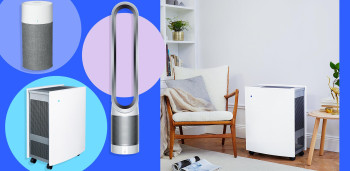
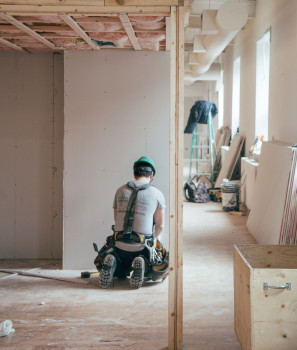
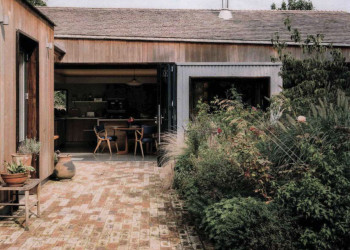
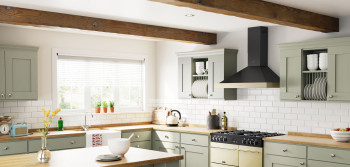







 Quiet Mark Founder
Quiet Mark Founder